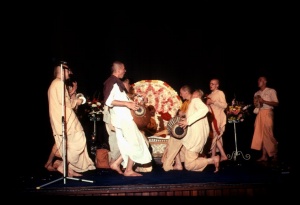CC Madhya 2.54: Difference between revisions
m (1 revision(s)) |
(Vanibot #0054 edit - transform synonyms into clickable links, which search similar occurrences) |
||
| (One intermediate revision by one other user not shown) | |||
| Line 1: | Line 1: | ||
{{ | [[Category:Sri Caitanya-caritamrta - Madhya-lila Chapter 02|C054]] | ||
<div style="float:left">'''[[Sri Caitanya-caritamrta|Śrī Caitanya-caritāmṛta]] - [[CC Madhya|Madhya-līlā]] - [[CC Madhya 2|Chapter 2: The Ecstatic Manifestations of Lord Śrī Caitanya Mahāprabhu]]'''</div> | |||
<div style="float:right">[[File:Go-previous.png|link=CC Madhya 2.53|Madhya-līlā 2.53]] '''[[CC Madhya 2.53|Madhya-līlā 2.53]] - [[CC Madhya 2.55|Madhya-līlā 2.55]]''' [[File:Go-next.png|link=CC Madhya 2.55|Madhya-līlā 2.55]]</div> | |||
{{CompareVersions|CC|Madhya 2.54|CC 1975|CC 1996}} | |||
{{RandomImage}} | |||
==== TEXT 54 ==== | ==== TEXT 54 ==== | ||
<div | <div class="verse"> | ||
garuḍera sannidhāne, rahi’ kare daraśane, | :garuḍera sannidhāne, rahi’ kare daraśane, | ||
se ānandera ki kahiba ba’le | :se ānandera ki kahiba ba’le | ||
garuḍa-stambhera tale, āche eka nimna khāle, | :garuḍa-stambhera tale, āche eka nimna khāle, | ||
se khāla bharila aśru-jale | :se khāla bharila aśru-jale | ||
</div> | </div> | ||
| Line 14: | Line 18: | ||
==== SYNONYMS ==== | ==== SYNONYMS ==== | ||
<div | <div class="synonyms"> | ||
''[//vanipedia.org/wiki/Special:VaniSearch?s=garuḍera&tab=syno_o&ds=1 garuḍera]'' — Garuḍa; ''[//vanipedia.org/wiki/Special:VaniSearch?s=sannidhāne&tab=syno_o&ds=1 sannidhāne]'' — near; ''[//vanipedia.org/wiki/Special:VaniSearch?s=rahi’&tab=syno_o&ds=1 rahi’]'' — staying; ''[//vanipedia.org/wiki/Special:VaniSearch?s=kare&tab=syno_o&ds=1 kare]'' — does; ''[//vanipedia.org/wiki/Special:VaniSearch?s=daraśane&tab=syno_o&ds=1 daraśane]'' — seeing; ''[//vanipedia.org/wiki/Special:VaniSearch?s=se&tab=syno_o&ds=1 se] [//vanipedia.org/wiki/Special:VaniSearch?s=ānandera&tab=syno_o&ds=1 ānandera]'' — of that bliss; ''[//vanipedia.org/wiki/Special:VaniSearch?s=ki&tab=syno_o&ds=1 ki]'' — what; ''[//vanipedia.org/wiki/Special:VaniSearch?s=kahiba&tab=syno_o&ds=1 kahiba]'' — I shall say; ''[//vanipedia.org/wiki/Special:VaniSearch?s=ba’le&tab=syno_o&ds=1 ba’le]'' — on the strength; ''[//vanipedia.org/wiki/Special:VaniSearch?s=garuḍa&tab=syno_o&ds=1 garuḍa]'' — of the statue of Garuḍa; ''[//vanipedia.org/wiki/Special:VaniSearch?s=stambhera&tab=syno_o&ds=1 stambhera]'' — of the column; ''[//vanipedia.org/wiki/Special:VaniSearch?s=tale&tab=syno_o&ds=1 tale]'' — underneath; ''[//vanipedia.org/wiki/Special:VaniSearch?s=āche&tab=syno_o&ds=1 āche]'' — there is; ''[//vanipedia.org/wiki/Special:VaniSearch?s=eka&tab=syno_o&ds=1 eka]'' — one; ''[//vanipedia.org/wiki/Special:VaniSearch?s=nimna&tab=syno_o&ds=1 nimna]'' — low; ''[//vanipedia.org/wiki/Special:VaniSearch?s=khāle&tab=syno_o&ds=1 khāle]'' — ditch; ''[//vanipedia.org/wiki/Special:VaniSearch?s=se&tab=syno_o&ds=1 se] [//vanipedia.org/wiki/Special:VaniSearch?s=khāla&tab=syno_o&ds=1 khāla]'' — that ditch; ''[//vanipedia.org/wiki/Special:VaniSearch?s=bharila&tab=syno_o&ds=1 bharila]'' — became filled; ''[//vanipedia.org/wiki/Special:VaniSearch?s=aśru&tab=syno_o&ds=1 aśru]-[//vanipedia.org/wiki/Special:VaniSearch?s=jale&tab=syno_o&ds=1 jale]'' — with the water of tears. | |||
</div> | </div> | ||
| Line 21: | Line 25: | ||
==== TRANSLATION ==== | ==== TRANSLATION ==== | ||
<div | <div class="translation"> | ||
Staying near the Garuḍa-stambha, the Lord would look upon Lord Jagannātha. What can be said about the strength of that love? On the ground beneath the column of the Garuḍa-stambha was a deep ditch, and that ditch was filled with the water of His tears. | Staying near the Garuḍa-stambha, the Lord would look upon Lord Jagannātha. What can be said about the strength of that love? On the ground beneath the column of the Garuḍa-stambha was a deep ditch, and that ditch was filled with the water of His tears. | ||
</div> | </div> | ||
| Line 28: | Line 32: | ||
==== PURPORT ==== | ==== PURPORT ==== | ||
<div | <div class="purport"> | ||
In front of the temple of Jagannātha is a column on which the statue of Garuḍa is situated. It is called the Garuḍa-stambha. At the base of that column is a ditch, and that ditch was filled with the tears of the Lord. | In front of the temple of Jagannātha is a column on which the statue of Garuḍa is situated. It is called the Garuḍa-stambha. At the base of that column is a ditch, and that ditch was filled with the tears of the Lord. | ||
</div> | </div> | ||
__NOTOC__ | |||
<div style="float:right; clear:both;">[[File:Go-previous.png|link=CC Madhya 2.53|Madhya-līlā 2.53]] '''[[CC Madhya 2.53|Madhya-līlā 2.53]] - [[CC Madhya 2.55|Madhya-līlā 2.55]]''' [[File:Go-next.png|link=CC Madhya 2.55|Madhya-līlā 2.55]]</div> | |||
__NOTOC__ | |||
__NOEDITSECTION__ | |||
Latest revision as of 22:34, 19 February 2024

A.C. Bhaktivedanta Swami Prabhupada
TEXT 54
- garuḍera sannidhāne, rahi’ kare daraśane,
- se ānandera ki kahiba ba’le
- garuḍa-stambhera tale, āche eka nimna khāle,
- se khāla bharila aśru-jale
SYNONYMS
garuḍera — Garuḍa; sannidhāne — near; rahi’ — staying; kare — does; daraśane — seeing; se ānandera — of that bliss; ki — what; kahiba — I shall say; ba’le — on the strength; garuḍa — of the statue of Garuḍa; stambhera — of the column; tale — underneath; āche — there is; eka — one; nimna — low; khāle — ditch; se khāla — that ditch; bharila — became filled; aśru-jale — with the water of tears.
TRANSLATION
Staying near the Garuḍa-stambha, the Lord would look upon Lord Jagannātha. What can be said about the strength of that love? On the ground beneath the column of the Garuḍa-stambha was a deep ditch, and that ditch was filled with the water of His tears.
PURPORT
In front of the temple of Jagannātha is a column on which the statue of Garuḍa is situated. It is called the Garuḍa-stambha. At the base of that column is a ditch, and that ditch was filled with the tears of the Lord.